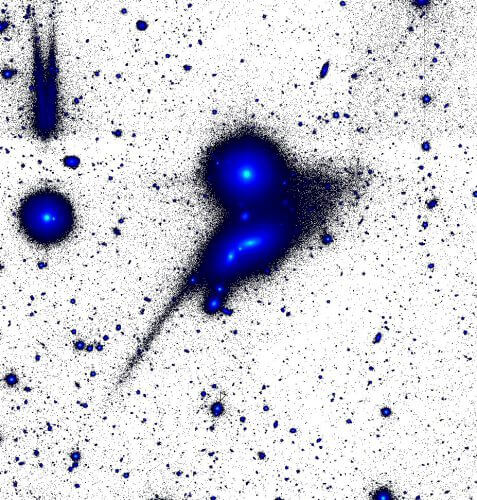Astronomers at Tel Aviv University's Wise Observatory in Mitzpe Ramon The researchers identified a celestial body in the shape of a tadpole with a huge tail that is about 500,000 light-years long, about 300 million light-years away from us; According to them, the 'Tadpole' is made of the remains of a dwarf galaxy that was formed while it was swallowed by two nearby large galaxies

Researchers from Tel Aviv University, led by Dr. Noah Brosh from the School of Physics and Astronomy, have identified an unknown celestial body at a distance of about 300 million light years from us: a kind of 'head' with an elliptical 'head' in the center of which are two galaxies, and behind it a huge 'tail' in length of about 500,000 light years. The researchers believe that the discovery is new and tangible evidence of a fascinating process in the universe: the swallowing of a dwarf galaxy by the two large galaxies nearby.
The research was conducted in collaboration with scientists at the University of California in Los Angeles and the Russian Academy of Sciences, and the observations were made at the Wise Observatory in Mitzpe Ramon, which belongs to Tel Aviv University and with the same telescope in the USA. The article is published today (Monday) in the scientific journal of the Royal Astronomical Society of Great Britain (Monthly Notices of the Royal Astronomical Society).
"We are looking for 'action' in the sky," says Dr. Brosh. "We observe galaxies and the regions close to them to detect evidence of changes: is the galaxy growing or shrinking? Is it in any interaction with other galaxies? Among other things, we observe dense groups of galaxies, assuming that when the galaxies are close to each other, more interactions will occur between them," explains Dr. Brosh. "This type of dense galaxy groups is called the Hickson Compact Group HCG) after the Canadian astronomer Paul Hickson
who identified them in 1982. Unlike galaxy clusters that include many thousands of galaxies, HCG groups only include single galaxies, so it is relatively easy for us to identify and understand interactions that occur between them. The group of galaxies observed in the current study is called HCG 98."
HCG 98 is a dense group of four galaxies, located 300 million light years away. For comparison, the edge of the visible universe is about 14 billion light-years away from here, so the HCG 98 group is actually a relatively close neighbor... In the observations and their interpretation, the astronomers were helped by special technology: a telescope purchased about five years ago, with a structure that allows observation and photography of a relatively large area in the sky; and a processing method, which joins together many photographs of the same area, and allows researchers to distinguish even very pale bodies, which cannot be seen in any other way.
A billion year event
These observations of the HCG 98 group revealed a new and unusual find: a huge tadpole-shaped celestial body, which was not discovered until now because it shines with an extremely pale light. "The tadpole consists of a head in the center of which are two regular galaxies, followed by a huge tail, about 500,000 light-years long," says Dr. Brosh. "We believe that this is tangible evidence of a process that is constantly taking place in the universe: the disintegration of dwarf galaxies by larger galaxies. Such an event, which lasts about a billion years, occurs when the stars of the dwarf galaxy are pulled by the gravity of the larger galaxies. In the case before us, the head of the tadpole was apparently formed from the stars of the dwarf galaxy that were close to the two 'predatory' galaxies, observed in the center of the head; Whereas the giant tail is made up of the remnants of more distant stars in the collapsing galaxy. In fact, our observation captured the dissolution process in its midst."
These days, the researchers at the Wise Observatory are continuing a large project that uses the special technology to detect events near about a hundred galaxies throughout the universe.

2 תגובות
Where exactly do you see a tadpole??
When you see the exact same article in Israel today 20.11 with the correct picture you will understand exactly which tadpole they are talking about. The picture here is wrong and does not belong to the article.
And so a galactic "embryo" was created in the womb of space. You see the tadpole, but where did the egg go?